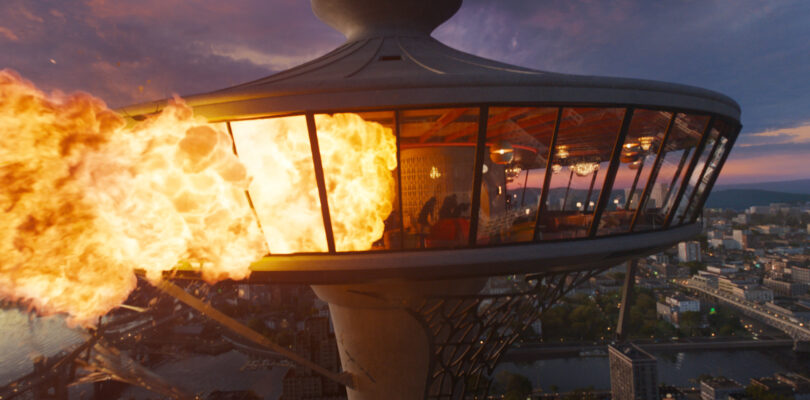Every horror nerd has that one subgenre that, for whatever reason, they can’t totally shake off. At a certain point, one just builds up enough of a tolerance for ghost stories or slasher flicks or zombie mukbangs that their more terrifying aspects just stop having the same effect – one knows too much about them, structure, staging, editing, etc. – that even lengthy tolerance breaks can’t fully hit in the same way they did (this is also why those fans are often the most adventurous and curious: They’re chasing a high that can only ever be temporarily sated by Hollywood, and seek out small-budget or foreign films to get a kick). But there’s always that particular type, a subgenre or franchise or so on, that makes the skin crawl. For some, it’s body horror. For others, it’s a dread-heavy atmosphere that never quite breaks into the comfort of a jump scare. For me, it’s the Final Destination series, of which Final Destination: Bloodlines is a more-than-serviceable entry than you’d expect after a decade of dormancy.
Let me be clear: I love this series. It’s the most consistently creative and entertaining franchise in studio horror, one that doesn’t need the mangled world-building of the Saw movies, the “heart” of the Conjurings, or the gimmicks that sustained its successors like the Paranormal Activity features (every time the series tried to traffic in faddish stunts like CGI kills or 3D, it failed). The rules are simple: evade Death’s grand plans and pay the price in hideously complex ways. The cliché description of the kills being bloody “Rube Goldberg machines” has never quite cut it for me, perhaps because of how little it captures the essentially cinematic nature of these sequences. When looking at a Goldberg machine, the viewer supplied their perspective – after all, they saw it from static positions – and here, Death’s machinations guide one’s attention down a parade of possibilities. Think of them as chaotic proofs: Give them an equation and variables, and it’ll solve for X. They capitalize and innovate on long-standing cinematic concepts of suspense – Hitchcock’s bomb if it were made from blood, bone, and irony. It’s perfect fodder for an anxious mind already cursed by pattern recognition, where the puzzle itself is even worse than the solution. Nothing makes me want to fucking shout at the screen more than enduring the set-up for some poor bastard to get what’s coming to him.
Holding all of this tension successfully without dipping into outright nihilism or straight black comedy requires a steady hand. The Monkey had Osgood Perkins, who skewed the balance towards the latter. In the case of Final Destination: Bloodlines, two captains are at the helm, and they keep the whole ship on a steady heading. Looking at the resumes of Zach Lipovsky and Adam Stein, it wouldn’t immediately be evident that they had it in them to knock a Final Destination sequel out of the park. Sure, they did the minor indie hit Freaks with Emile Hirsch, but they also did the Kim Possible movie for Disney, which is as disparate as a skill set as a plumber knowing Aramaic: it’s not entirely impossible, but it’s certainly unexpected to hear dead languages while someone’s fixing your garbage disposal. One might expect them to try and be trendy, doing an “elevated horror” riff to modernize the franchise, given that the last time it was in theaters, Barack Obama was still in his first term as President. Everyone, Osgood Perkins included, should thank God that they didn’t. Lipovsky and Stein decided to make a timeless Final Destination movie – sure, the phones and styles might be a little different, but you could easily see these characters hanging out with the folks in 2 before they got turned into red paste by a giant log careening across the freeway. The character archetypes are as stale as they’ve ever been, but they’re genuinely well-written and frequently funny. Importantly, they do not strive for meaning.
Instead, like the best horror sequels do, Lipovsky and Stein decided to answer questions that nobody asked – or, if they did, were at least one grav-bong hit away from unconsciousness when they thought them up – and they’re our subjects in the grand experiment. For instance, what if a person saved enough people from one of those mass-casualty events that it threw a real wrench into Death’s plans? Say you save a few hundred people from a collapsing Space Needle knock-off like in the (astonishing) opening sequence: Death has to kill all those people in the order that they were supposed to die (as established by the rules of the franchise), and the circumstances for a good kill take a little time to unfold. So, the would-be victim goes on and gets married and has kids that they shouldn’t have had. That means Death’s got even more killing to do – he’s God’s gag writer, after all, and he has to be creative! Another thing: What if one of those kids is adopted? Another: what happens to the should-be-dead person’s spouse? And what if someone figures out a way in which they can keep Death perpetually at their door?
All these questions and more are answered in the most entertaining ways possible. This is the funniest possible adaptation of The Body Keeps the Score, in which epigenetics and generational trauma quite literally make manifest in its sufferers and ruin their lives. If all of that is a ticking time bomb, it’s by far the most interesting kind of metaphor for it, which is something that the Final Destination movies have always excelled at – the first one, after all, came out shortly before 9/11 (had it been delayed by a year, the franchise would not exist). It’s not just survivor’s guilt that’s stalking our protagonist (Kaitlyn Santa Juana) this time around; it’s the fact that her very existence would not be possible without some bizarre intuitive intervention and that she’s been living on stolen time. It’s a clever inversion of how the franchise typically works, an admirable switch-up for the formula that pays off in how it makes the familiar fresh.
I don’t want to spoil any of the bloody good stuff you’ll see during Bloodlines, so let me leave you with two parting thoughts. First, that opening sequence – a ‘60s-set disaster sequence that plays like a significantly gorier Irwin Allen movie (minus the celebrities) in which No Child Really is Left Behind – makes me want a period Final Destination so severely that I’m shocked no one has green-lit it yet. Second: Tony Todd’s appearance in this is a fitting tribute to the iconic actor (may he rest in peace), but seeing him on screen here in the final months of his illness is genuinely distressing. He still has the fire, effortlessly giving the scene some gravitas, but something is discomfiting about the acknowledgment of a real death after chuckling along after, say, a bunch of people got massacred because some shithead kid decided to throw a penny off of the not-Space Needle.
It breaks the illusion just enough to start asking those uncomfortable questions, which Bloodlines does not want to (nor has to) answer. Then again, that reality makes these movies creepy: You’re always one or two coincidences away from meeting the Reaper yourself.




